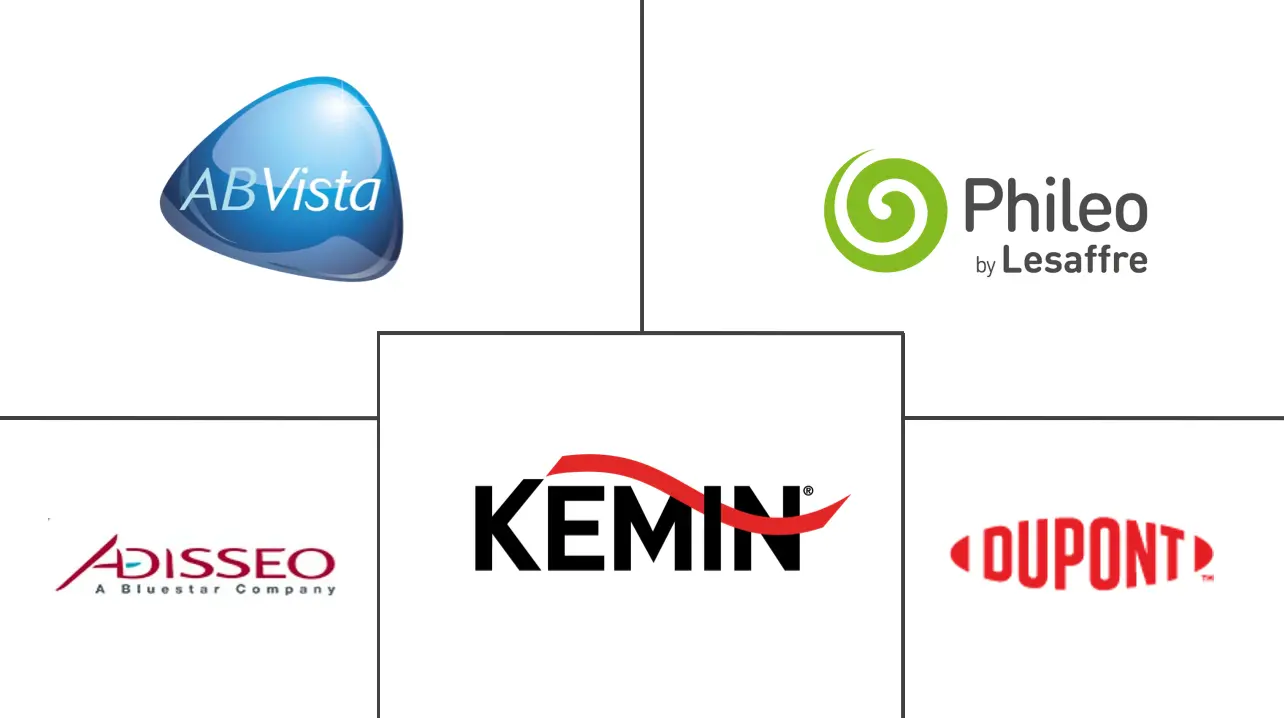Global Animal Intestinal Health Market Size and Share
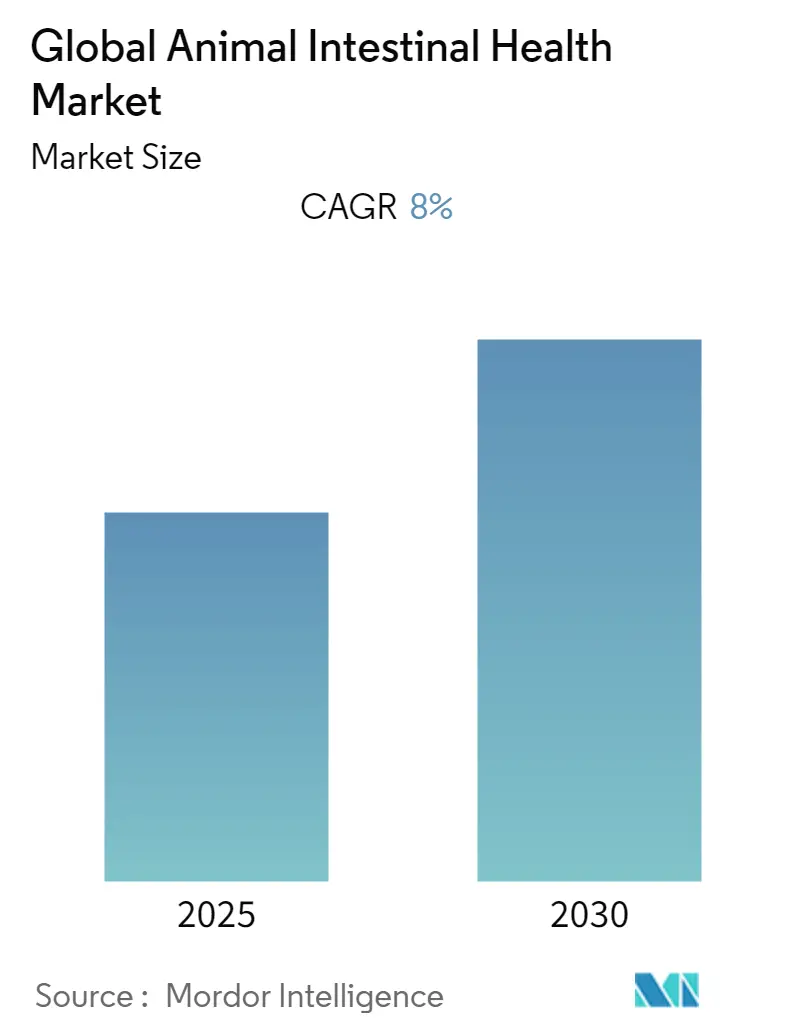
Global Animal Intestinal Health Market Analysis by Mordor Intelligence
The Global Animal Intestinal Health Market is expected to register a CAGR of 8% during the forecast period.
During the COVID-19 pandemic, livestock production and supply plunged due to the restrictions placed on transportation and social distancing factors. According to an article presented in Frontiers in Veterinary Science in September 2020, the initial effects of COVID caused the increased sale of meat and dairy products due to panic buying. However, the disruption of the livestock product supply chain and the closing down of schools and restaurants led to decreased product supply. With the reduction in COVID-19 cases and restrictions being taken back worldwide, the animal intestinal health market is expected to get back on track.
Animal Intestinal Health is an important factor in determining the animal's overall health. The effective functioning of the Gastrointestinal tract (GIT) corresponds to the proper nutrient digestion and absorption. The Pennsylvania State University, in its May 2020 article on Gut Health in Cattle, described gut health as how well the nutrients from the feed are absorbed and how well pathogens are contained within the digestive tract. An article presented in Frontiers in Veterinary Science in January 2022 defines gut health as physiological and functional factors, including nutrient digestion and absorption, host metabolism and energy generation, a stable and applicable microbiota/microbiome, defense mechanisms, and the interactions between these factors. The article also suggests that good intestinal health will contribute to the creation of intestinal epithelial barrier, host immune system development, and prevent the harmful propagation of pathogenic bacteria.
According to a research article published in the Édition Diffusion Presse Sciences in 2020, diseases affecting the gastrointestinal tract of livestock have the largest percentage of all diseases, which cause significant economic damage associated with high mortality and treatment costs. An article published in the Biomedical Journal of Scientific and Technical Research in February 2022 indicated that the growth in the human population, higher prosperity, and urbanization are driving the demand for livestock feed products. The great demand for livestock feed, along with the increase in the diseases affecting the gastrointestinal tract of the livestock, are propelling the growth of the animal intestinal health market in the forecast period.
An article presented in the Journal of Animal Physiology and Animal Nutrition in September 2020 reviewed the increasing use of antibiotic alternatives in animal feed. The article inferred that the probiotics and other antibiotic replacement supplements such as prebiotics, organic acids, and other spore formers help increase the intestinal immune response, thereby aiding in the overall health performance of the livestock.
Researchers from the University of Edinburgh published an article in January 2021 on the effects of gut bacteria on animal health. Scientists sequenced the DNA in the gut contents of cows, sheep, and other ruminants and discovered almost 5000 new microbes. The findings would help in the improvement of dairy and meat yields. Also, the discovery would help determine the microbes essential for energy retention from the diet and gut health. According to an article published in Frontiers in Nutrition in August 2021, disturbances in the gastrointestinal tract of the ruminants can cause various metabolic disorders such as bloat, ruminal acidosis, hypoglycemia, diarrhea, ulcers in the gastrointestinal (GI) tract, and retivuloperitonitis. Hence, the need for feed supplements is expected to drive the growth of the animal intestinal health market in the forecast period.
Global Animal Intestinal Health Market Trends and Insights
The Probiotics Segment is Expected to Hold a Major Market Share in the Animal Intestinal Health Market.
Probiotics are a major fraction of the feed supplements used in the livestock industry. Probiotics are microbial feed supplements that, when consumed adequately, bestow health benefits on the host. An article published in the Journal of Basic and Applied Zoology in October 2021 discussed the drawbacks of using antibiotics to prevent animal diseases and how antibiotics could be replaced with probiotics. Probiotics could be beneficial in the improvement of health and growth of livestock and fish. Another article published in BioMed Central (BMC) Zoology in April 2021 conferred that probiotics help increase the rate of digestion in animals. The article proposed that probiotics can enhance broilers' cecal microorganism constitution and nutrient digestion. A research study published in the journal of Aquaculture in 2021 studied the effects of probiotics on the fish Tilapia. It concluded that they were vital in growth performance and nutrient utilization.
According to an article published in the journal of Sustainability in February 2020, probiotics are being increasingly used as a safe and viable alternative to antibiotics for increasing performance in livestock. The article showed that several health agencies worldwide have established and documented adequate safety protocols for probiotics development. As per the article in the Journal of Agriculture in October 2020, probiotics improved gut microbiota composition, immune response, nutrient digestibility and absorption, animal growth, and meat quality. The authors also suggested that further studies characterizing specific strains, identifying the optimal dosage, and understanding the network of interactions between probiotics and the gut microbiota could help formulate more effective probiotic mixtures for animal feed and meat products.
Another article published in the journal of Agriculture in October 2020 suggested that using probiotics in farm animals decreased morbidity and vitality, improved feeding behavior, and increased production yield. Also, probiotic use has expanded into the food industry due to its ability to inhibit a wide range of pathogenic microbes. Another article in the journal of Animals in October 2020 reviewed the effects of probiotics on poultry nutrition utilization, growth and laying performance, and gut health. The article showed that the probiotic supplement helped in the improvement of the body weight of the broiler chicken. The increase in the research activities concerning the use of probiotics and the helpful nature of probiotics is expected to propel the growth of the animal intestinal health market in the forecast period. However, the various regulations laid by the governments on the use of probiotics in the livestock industry are likely to hamper the market's growth.
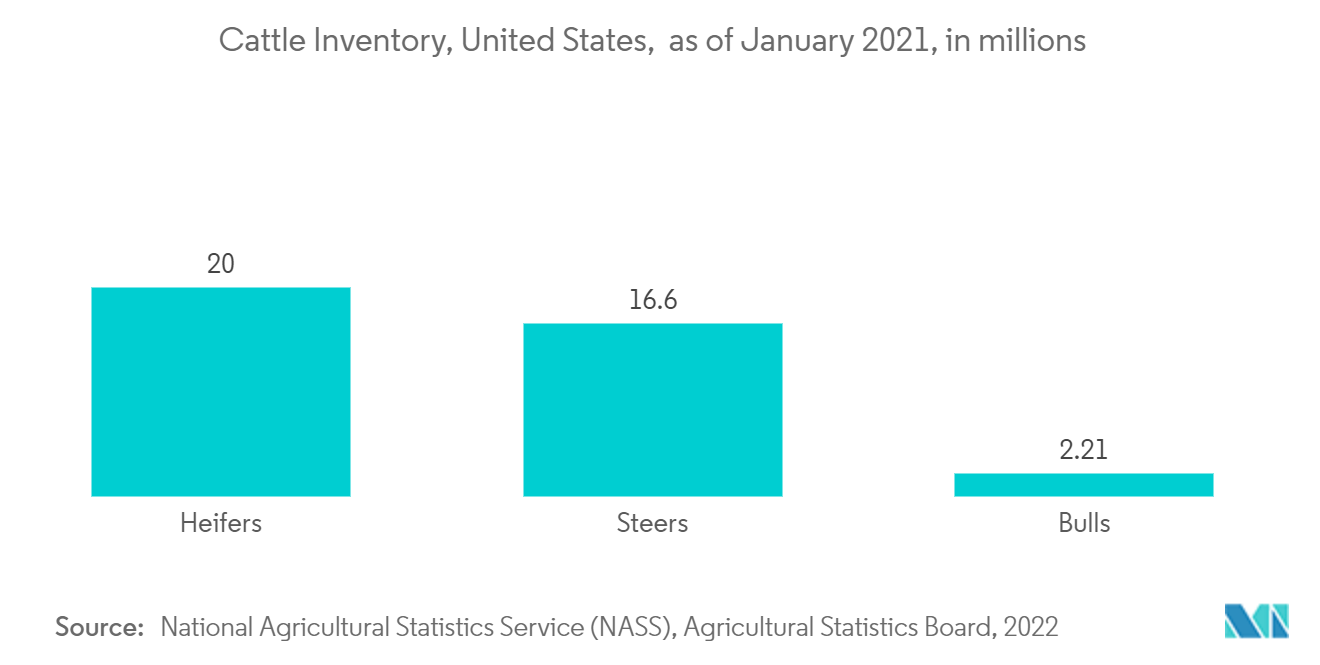
North America is Expected to Hold a Significant Share in the Market and Expected to do Same in the Forecast Period (2022-2027).
The United States of America is one of the largest consumers of meat and dairy products. According to Organisation for Economic Co-operation and Development - Food and Agriculture Organization (OECD-FAO) agricultural outlook 2021, the United States consumed around 43,810 thousand tonnes of poultry, sheep, pork, beef, and veal, constituting around 34.43% of the total meat consumption in the world. A large amount of meat consumption by the United States is expected to propel the market's growth in the forecast period. According to the United States Department of Agriculture's Economics, Statistics and Market Information System, as of January 2022, the United States produced around 12,383 thousand metric tonnes of beef and veal, 12,478 thousand metric tonnes of pork, and 20,712 thousand metric tonnes of chicken. The large production volumes are mainly attributed to the increased consumption of meat products. As per the United States Department of Agriculture's Economic Research Service, the United States had produced over 2,26,258 million pounds of milk in the year 2021. The increased consumption of meat and dairy products requires the proper maintenance of the livestock.
As per the Cattle inventory released by the National Agricultural Statistics Service (NASS), Agricultural Statistics Board, United States Department of Agriculture (USDA) in January 2021, the United States had around 93.8 million cattle and calves, with beef cows at 31.2 million and milk cows at 9.44 million. The total number of heifers accounted for 20 million, with beef replacement heifers at 5.81, milk replacement heifers at 4.6 million, and other heifers at 9.58 million. The number of steers had increased from the previous year to 16.6 million, and the total number of bulls as of January 2021 was 2.21 million. The number of cattle and calves for the slaughter market in the United States was about 14.7 million, slightly increasing from 2020.
The United States Department of Agriculture (USDA), in 2021, showed that livestock and poultry accounted for over half of United States agricultural cash receipts, exceeding USD 100 billion per year. In its 2022 Feed Industry Stats, the American Feed Industry Association estimated that the total volume of feed consumption in the United States is projected to grow to 263.1 million tonnes in 2025 from 248.4 million tonnes in 2020, in the best case scenario. The huge production and consumption of meat and dairy products in the United States are expected to improve the livestock count in the region. The increasing livestock count and the associated animal feed required for the healthy maintenance of the livestock is likely to advance the expansion of the animal intestinal health market in the North American region.
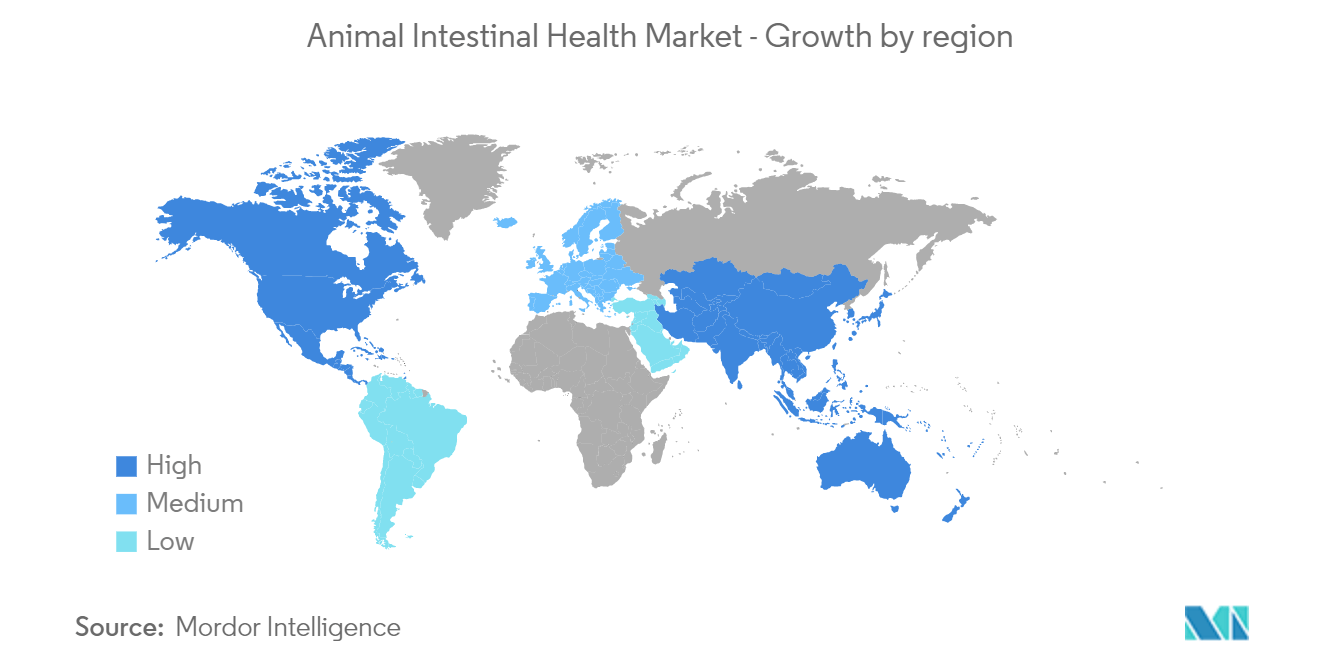
Competitive Landscape
The Animal Intestinal Health market is fragmented and competitive and consists of several major players. In terms of market share, a few major players dominate the market. Some of the companies which are currently dominating the market are AB Vista, Agrihealth, Alltech, Anco Animal Nutrition Competence GmbH (Archer Daniels Midland Company), ARM & Hammer Animal Nutrition, Beneo, Biorigin, Bluestar Adisseo (Novozymes), Calpis Co., Ltd, Cargill, Incorporated, Chr. Hansen Holding A/S, Delacon Biotechnik Ges.M.B.H., Dr. Eckel Animal Nutrition, DuPont, Evonik Industries, Kemin Industries, Inc., Koninklijke DSM N.V., Lallemand Inc., Land O' Lakes, Lesaffre, Nutreco N.V, Ohly, Phytobiotics Futterzusatzstoffe GmbH, Pure Cultures, Unique Biotech, and others.
Global Animal Intestinal Health Industry Leaders
-
AB Vista
-
Bluestar Adisseo (Novozymes)
-
DuPont
-
Kemin Industries, Inc.
-
Lesaffre
- *Disclaimer: Major Players sorted in no particular order
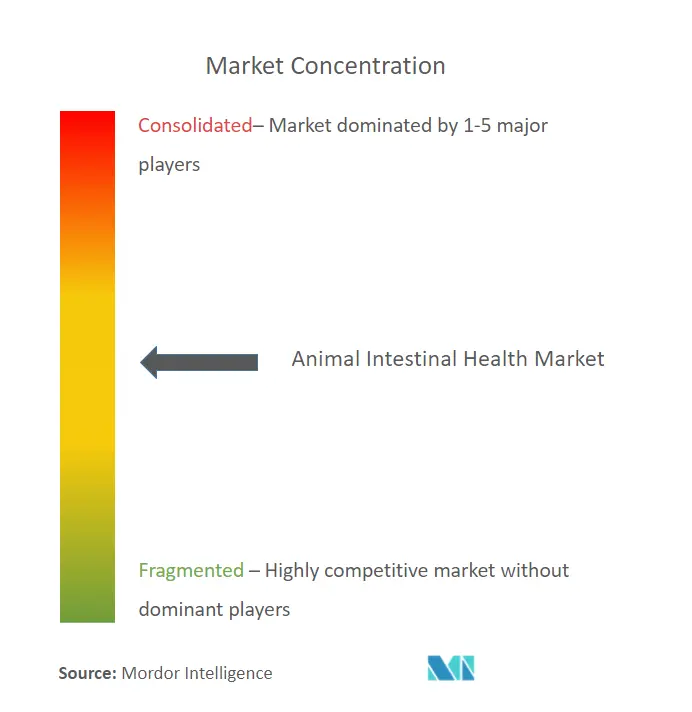
Recent Industry Developments
- In April 2022, Alltech introduced a second-generation feed supplement, Bio-Mos 2, to feed the gastrointestinal tract in cattle, optimizing average daily gains, aiding calf immune system development, and reinforcing a healthy gut microbiome without antibiotics at any stage of production.
- In July 2022, Grain Processing Corporation (GPC) launched FYBRIN RS resistant starch at this year's IFT Expo in Chicago. The new corn-based resistant starch is an inherently gluten-free dietary fiber ingredient with minimal calories.
Global Animal Intestinal Health Market Report Scope
As per the scope of this report, Animal Intestinal Health refers to gut health as physiological and functional factors, including nutrient digestion and absorption, host metabolism and energy generation, a stable and applicable microbiota/microbiome, defense mechanisms, and the interactions between these factors. The Animal Intestinal Health market is segmented by Livestock (Aquaculture, Poultry, Ruminant, Swine, and others), Additive (Probiotics, Prebiotics, Immunostimulants, and Phytogenics), Form (Dry and Liquid), Source (Microbial and Plant Based) and Geography (North America, Europe, Asia-Pacific, Middle East, and Africa, and South America). The Market report also covers the estimated market sizes and trends of 17 countries across major regions globally. The report offers values (in USD million) for the above segments.
| Aquaculture |
| Poultry |
| Ruminant |
| Swine |
| Others |
| Probiotics |
| Prebiotics |
| Immunostimulants |
| Phytogenics |
| Dry |
| Liquid |
| Microbial |
| Plant Based |
| North America | United States |
| Canada | |
| Mexico | |
| Europe | Germany |
| United Kingdom | |
| France | |
| Italy | |
| Spain | |
| Rest of Europe | |
| Asia-Pacific | China |
| Japan | |
| India | |
| Australia | |
| South Korea | |
| Rest of Asia-Pacific | |
| Middle-East and Africa | GCC |
| South Africa | |
| Rest of Middle-East and Africa | |
| South America | Brazil |
| Argentina | |
| Rest of South America |
| By Livestock | Aquaculture | |
| Poultry | ||
| Ruminant | ||
| Swine | ||
| Others | ||
| By Additive | Probiotics | |
| Prebiotics | ||
| Immunostimulants | ||
| Phytogenics | ||
| By Form | Dry | |
| Liquid | ||
| By Source | Microbial | |
| Plant Based | ||
| Geography | North America | United States |
| Canada | ||
| Mexico | ||
| Europe | Germany | |
| United Kingdom | ||
| France | ||
| Italy | ||
| Spain | ||
| Rest of Europe | ||
| Asia-Pacific | China | |
| Japan | ||
| India | ||
| Australia | ||
| South Korea | ||
| Rest of Asia-Pacific | ||
| Middle-East and Africa | GCC | |
| South Africa | ||
| Rest of Middle-East and Africa | ||
| South America | Brazil | |
| Argentina | ||
| Rest of South America | ||
Key Questions Answered in the Report
What is the current Global Animal Intestinal Health Market size?
The Global Animal Intestinal Health Market is projected to register a CAGR of 8% during the forecast period (2025-2030)
Who are the key players in Global Animal Intestinal Health Market?
AB Vista, Bluestar Adisseo (Novozymes), DuPont, Kemin Industries, Inc. and Lesaffre are the major companies operating in the Global Animal Intestinal Health Market.
Which is the fastest growing region in Global Animal Intestinal Health Market?
Asia-Pacific is estimated to grow at the highest CAGR over the forecast period (2025-2030).
Which region has the biggest share in Global Animal Intestinal Health Market?
In 2025, the North America accounts for the largest market share in Global Animal Intestinal Health Market.
What years does this Global Animal Intestinal Health Market cover?
The report covers the Global Animal Intestinal Health Market historical market size for years: 2019, 2020, 2021, 2022, 2023 and 2024. The report also forecasts the Global Animal Intestinal Health Market size for years: 2025, 2026, 2027, 2028, 2029 and 2030.
Page last updated on:
Global Animal Intestinal Health Market Report
The Animal Intestinal Health Market is segmented by livestock, additive, form, source, and geography. The market analysis includes a value in USD million for these segments. The report offers a comprehensive industry overview and market forecast outlook to provide insights into future trends. Global Animal Intestinal Health analysis includes a historical overview and a market review to understand past developments.
The market growth is driven by various factors, and the report provides detailed industry research to highlight key drivers. Industry reports indicate significant market trends and market growth opportunities. The market segmentation covers different livestock categories such as aquaculture, poultry, ruminant, swine, and others.
Additives like probiotics, prebiotics, immunostimulants, and phytogenics are analyzed for their market value and impact on the industry. The report also examines the form and source of these additives, including dry and liquid forms, and microbial and plant-based sources.
Industry information and market data are crucial for understanding the market size and market share. The report example and report PDF are available for further insights. Market leaders in the industry are highlighted, providing an understanding of key players and their strategies.
Market predictions and industry outlook are based on current trends and future projections. The report includes industry statistics and market segmentation to offer a detailed view of the market landscape. Industry sales and market value are analyzed to understand the financial aspects of the market.
Overall, this industry report provides a thorough market overview, including industry analysis and market forecast. It is essential for research companies and stakeholders to stay informed about the industry trends and market outlook. The report is a valuable resource for understanding the dynamics of the Animal Intestinal Health Market.
